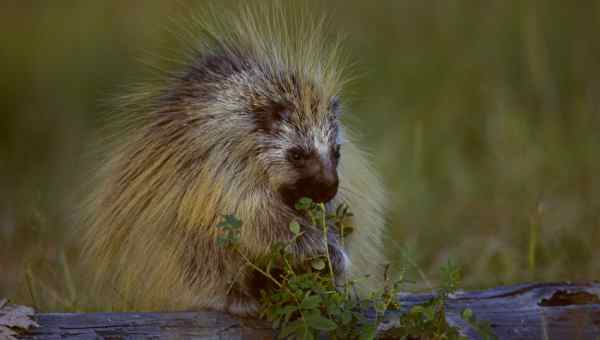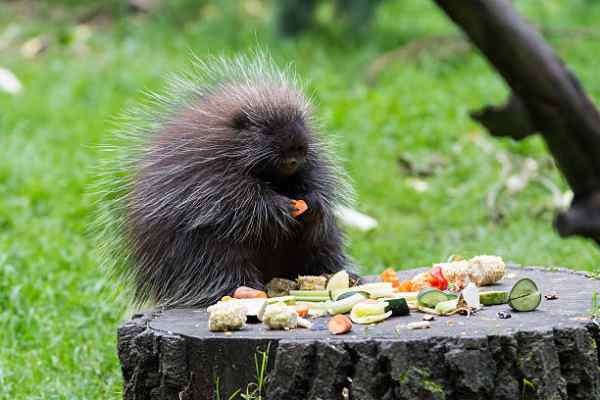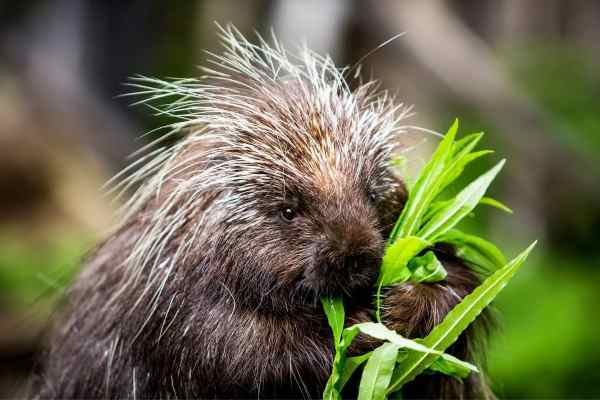The name “porcupine” comes from the Middle French word “porc espin,” which means “spined pig.”
There are two types of porcupines: those from the Old World and those from the New World. Porcupines from the old world live in Africa, Asia, and South Europe. Porcupines from the new world live in North, Central, and South America.
Table of Contents
This article explains what do porcupines eat and where they reside.

Porcupines Facts
The porcupine is an interesting animal with many fascinating attributes. Examples include the following.
Habitat
Depending on the species, porcupines can be found in many different places. For instance, porcupines in North America live in mixed and coniferous forests in Canada, northern Mexico, and the northeastern United States.
Most of the time, these animals are in trees and only come out at night. They descend to the ground in search of food and during the winter months when there is a little leaf on trees.
Porcupines from the Old World live on land in places like deserts, hillsides, and forests. Several of these porcupines spend a lot of time in trees and are excellent climbers and swimmers.
Characteristics
Porcupines are animals with sizes between medium and large. They have short legs and long tails, and their bodies are round. The porcupines in the Old World are bigger than those in the New World. Some of the Old World porcupines can weigh up to 77 pounds, while the North American porcupine weighs between 12 and 35 pounds.
The fur on a porcupine is black or dark brown. They use the stiff, sharp quills on their backs to defend themselves and scare off predators.

Reproduction
Porcupines typically live their lives alone. The mating of the male and female takes place exclusively during the breeding season, which lasts from the middle of summer until the beginning of fall.
Porcupines have a seven-month gestation span and often have one or two babies at a time. The young have soft quills upon birth, which harden over the course of the first few days.
The mother cares for her babies for about 18 months, until they are old enough to take care of themselves.
The Old World Porcupines VS. The New World Porcupines
The old-world porcupines (Family Hystricidae) and the new-world porcupines are different in many ways (Family Erethizontidae). Differences between the two types of porcupines are discussed below.
Old-World Porcupines
There are 11 different species of old-world porcupines, which are put into eight different groups called genera. These porcupines live in Southern Europe, Africa, and Asia.
The quills of porcupines from the Old World are longer and thinner than those of porcupines from the New World. The quills on their backs help them defend themselves and keep predators away. Most of the time, these porcupines are bigger than those in the New World. Some of them can weigh up to 77 pounds.
New World Porcupines
There are 18 species of porcupines in the New World, which are grouped into three genera. You can find these porcupines in North, Central, and South America.
The quills of porcupines in the New World are shorter and thicker than those of porcupines in the Old World. They can also use the quills on their backs to defend themselves and scare away predators.
Most of these porcupines are smaller than those in the old world, but some of them can weigh as much as 35 pounds.

What Do Porcupines Eat?
Porcupines don’t eat meat. Instead, they eat plants, fruits, and vegetables. They bite off pieces of bark from trees with their sharp front teeth. They also eat the plant’s stems, leaves, and roots.
In the wild forest, porcupines eat almost anything they can find, such as insects, small rodents, and small reptiles. But when they are kept in captivity, their diet is much more controlled. Most of what they eat is plants and vegetables.
But even though a porcupine’s diet seems to be the same in general, it changes depending on the time of year and the type of porcupine. Here is a list of what each type of porcupine eats.
- North American Porcupines
The porcupine native to North America is a herbivore, meaning that it consumes only plants, fruits, and vegetables for food. Some examples of the foods it consumes are carrots, bananas, apples, and sweet potatoes. Along with that, they consume the plant’s leaves, stems, and roots.
- Brazilian Porcupines
When it comes to food, the Brazilian porcupine isn’t picky. Fruits, vegetables, insects, rodents, and tiny reptiles make up the bulk of their food. Their skill as climbers serves them well in their search for food since they can reach high places to collect a variety of different types of plants and tiny animals.
- African Brush-tailed Porcupines
The brush-tailed porcupine is considered to be the biggest of all in Africa weighing upto 77 pounds. They are animals that are most active at night and spend the majority of their time in trees. The African brush-tail porcupine is a plant-eater that eats plants, fruits, and vegetables. They have also been seen eating dead animals.
- Asiatic Brush-tailed Porcupines
These porcupines aren’t as big as other old-world porcupines, but they are bigger than porcupines from the new world. They mostly eat plants and eat things like fruits, grubs, and bamboo shoots. However, they can also eat bugs and find bones and hones to eat.
- Sumatran Porcupines
Porcupines like these may be found on the Indonesian island of Sumatra, in the Surmattan area. They may weigh up to 60 pounds and are the biggest porcupines in Asia. A herbivore, the Sumatran porcupine subsists on a diet of sugarcane, melons, and beans. They will also consume insects and other animal waste to get their salt and potassium.
- South African Porcupines
The Cape porcupine, found in South Africa, is the biggest of the porcupine species. There have been records of 110-pound weights, and 13-inch long quills among them. Vegetables, fruits, roots, bulbs, and other plants make up the bulk of the South African porcupine’s diet. However, they also devour dead animals.
- Mexican Dwarf Hairy Porcupines
One of the smallest types of porcupine is the Mexican dwarf hairy porcupine. They live in Mexico, Central America, and South America and weigh between 2-4 pounds. The Mexican dwarf hairy porcupine is a herbivore that eats sweet potatoes, tree leaves, carrots, and bulbs.
- Bristle-spined Porcupines
The porcupine with the bristly spines lives in Central and South America. They are animals that are most active at night and spend the majority of their time in trees. The bristle-spined porcupine is a herbivore, which means it eats plants, fruits, vegetables, peanuts, and insects. But cocoa nuts are their favorite food, and they like to live close to cocoa plantations.
- Thick-spined Porcupines
The thick-spined porcupine lives in Indo-Malayan Asia and Africa. They are animals that are most active at night and spend a lot of their time in trees. The thick-spined porcupine doesn’t eat meat. Instead, it eats plants, fruits, vegetables, and insects. They can’t climb well, though, and would rather consume fallen fruits.

Porcupines’ Diet During Seasons
Porcupines usually eat plants, but this can change depending on the time of year. Porcupines eat more bark and twigs in the winter because they are looking for high-calorie food. This is because there aren’t as many fruits and vegetables around in the winter.
Porcupines eat more fruits and vegetables in the summer because they want food that has a lot of water in it. This is because they are more likely to get dehydrated when it is hot. Porcupines will eat meat if they can get it, but plants make up the majority of their diet.
What Animals Kill Porcupines?
Even though porcupines don’t get eaten very often, there are a few animals that eat them. A porcupine’s quills can be up to 13 inches long and are very sharp, making them hard to get rid of.
The African leopard is one of the animals that hunt porcupines, but cheetahs, lions, and hyenas also go after them. On foxes, wolves, wolverines, bobcats, fishers, lynxes, coyotes, owls, and even dogs in North America are also other predators.
Porcupines are also killed by humans for their meat and their quills. In some cultures, porcupine meat is considered a delicacy, and the quills are used to make art.
Even though they have many predators, porcupines can live in the wild because they have a strong way to protect themselves.
Are Porcupines Good For Anything?
Porcupines are often misunderstood and feared by people, but these spiky animals are good for the environment and other animals in many ways. Many predators eat porcupines because their meat is high in protein and fat. This makes porcupines an important part of the food chain. Porcupines also help stop the spread of Lyme disease because they eat ticks that are on other animals.
Porcupines are important in forests because they help keep trees from growing too fast and stop fires. By eating the bark of trees, they keep the population under control and help new trees grow. Porcupines are also known for their beautiful quills, which can be used to make art.
FAQs
Do porcupines eat meat?
Porcupines eat bark and stems. Nuts, tubers, seeds, grass, leaves, fruit, and buds. Porcupines chew on bones to sharpen their teeth.
Where does a porcupine sleep?
They don’t create nests; they sleep in trees, hollow logs, rocks, or root wads. Except for the mother and infant, porcupines are solitary except in severe winter weather.
What are porcupines good for?
They devour trees and shed branches, providing habitat for other animals. Free tree pruners.
Do porcupines like carrots?
It eats mostly Brosimum, Ficus, and Inga tree leaves. Buds, sweet potatoes, fruits, seeds, and carrots are also eaten.
Are porcupines friendly?
Porcupines aren’t harmful despite their appearance. They’re docile unless provoked. People believe porcupines can discharge venomous quills. Porcupine quills aren’t poisonous.
Final Words
Due to their quills, porcupines are mistakenly perceived as being hazardous. They are kind creatures, though, and they tend to keep to themselves. They are fascinating animals that contribute much to the ecosystem and have unusual diets.
Moreover, porcupines are crucial for the distribution of pollen and seeds. Studies have demonstrated that by transporting pollen over great distances, they can contribute to a greater genetic variation in plants.
Read our other Porcupines blogs below:
- Can Porcupines Shoot Their Quills? (True Or False)
- Are Porcupine Quills Poisonous
- Porcupine Sounds And Vocalizations and What They Mean
- Can Porcupines Climb Trees? [Answered With 4 Reasons

Rahul M Suresh
Visiting the Zoo can be an exciting and educational experience for all involved. As a guide, I have the privilege of helping students and visitors alike to appreciate these animals in their natural habitat as well as introducing them to the various aspects of zoo life. I provide detailed information about the individual animals and their habitats, giving visitors an opportunity to understand each one more fully and appreciate them in a more intimate way.









